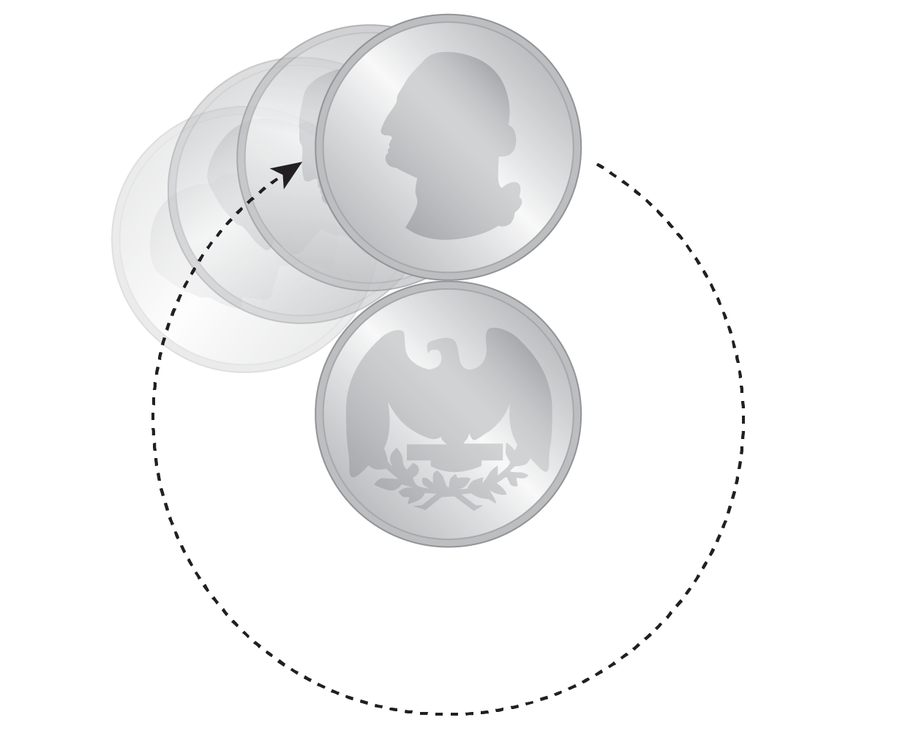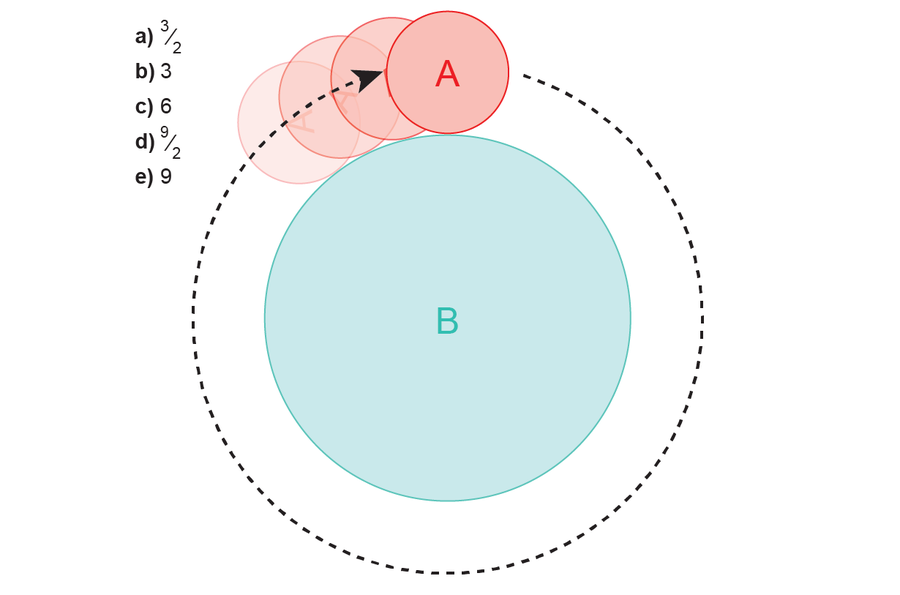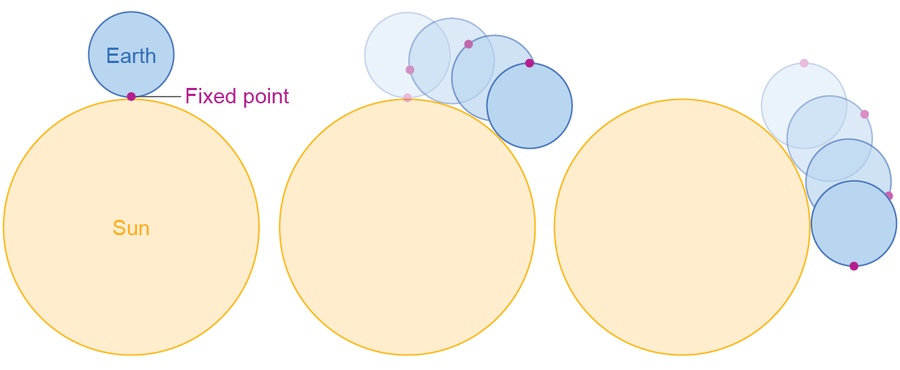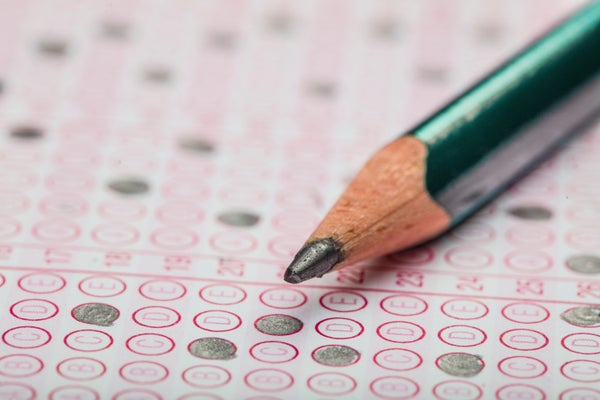The 1982 SAT infamously held a math question so tricky that even its creators didn’t include a correct answer. The botch required the rescoring of 300,000 exams, scholastic victims of the knotty coin rotation paradox.
Here’s how the paradox works: Place two quarters flat on a table so that they are touching. Holding one coin stationary on the table, roll the other quarter around it, keeping edge contact between the two without slipping. When the moving quarter returns to its starting location, how many full rotations has it made? In other words, how many times has George Washington returned to his upright position in the graphic below? If you dig puzzles like this, take a minute to think about it.

Credit: Amanda Montañez
Many people suspect that George will make one full rotation. A quarter’s circumference is about three inches around. So the moving quarter rolls along a path with a length of three inches, the same distance as its own circumference. If we wrap a string around a quarter and roll it along a three-inch path, unfurling the string as we go, then surely three inches of string will unfurl—just enough for a single rotation.
In fact, the moving quarter makes exactly two full rotations by the time it returns to its original position. The phenomenon defies common sense. If you find it hard to accept, I encourage you to test it for yourself. Any two disks of equal size will do.
The version of this problem that snuck its way onto the 1982 SAT math section had a small variation: the center disk was larger than the one rolling around it. Here’s a version of that problem, with the wording slightly modified for clarity:
The radius of circle B is three times the radius of circle A. Starting from the position shown in the figure, circle A rolls around circle B. When circle A returns to its starting point, how many rotations will it have completed?

Credit: Amanda Montañez
Does that seem familiar? Here, we’re told the larger circle’s radius is three times that of the smaller circle. This implies the same for the circumferences of the two circles: B is three times longer around its perimeter than A. It is tempting to reason that the smaller circle could “unwrap” itself exactly three times to encase the larger one. So “3” was the intended multiple-choice answer on the SAT. In fact, circle A makes four rotations on its trip—again, exactly one more rotation than intuition expects. The paradox was so far from the test writers’ awareness that four wasn’t offered as an option among the possible answers, so even the most astute students were forced to submit a wrong response. Three of the 300,000 students who took the test containing the question reported the issue to the College Board, and every exam had to be rescored.
So why is there an extra rotation? The approach that led us astray above does contain some wisdom. Rolling a quarter along a three-inch straight-line path would involve only one rotation. Likewise, a small circle rolling in a straight line with a length that is three times its diameter would rotate three times. So the circular shape of the path somehow causes a rotation of its own. To see why, imagine rolling a quarter around the perimeter of a tiny poppy seed. George will rotate once even though the length around the seed is negligible. So there are two sources of rotation: one from rolling along a path (the longer it is, the more rotations) and another from revolvingaround an object, which contributes one rotation regardless of its size.
Another helpful perspective comes from imagining rolling a quarter around a square. Each edge of the square is a straight-line segment, and George’s head will spin once for every three inches of length, but the moment you reach a corner, the quarter will have to rotate farther to clear that corner. (Again, try this for yourself if it’s hard to picture.) It turns out that this extra rotation at the corners is exactly 90 degrees, which results in one full rotation (360 degrees) by the time the coin traverses all four corners of the square and returns to its start. Similarly, rolling around a triangle would entail 120-degree rotations around each corner.
The effect scales up to celestial bodies. The moon famously has a far side and always shows the same face to us Earthlings. Many people erroneously interpret the unchanging view of the moon to mean that it must not spin about its axis like Earth does. If the moon didn’t spin during its orbit, though, we would see its far side from some places on Earth. You can demonstrate this with your own fists—hold one steady and orbit the other around it, without any rotation. Observers standing on one of your stationary knuckles will get a different glimpse of the orbiting fist at different times. To eternally hide its derriere, the moon has to rotate once every time it completes an orbit. (This perfect parity between orbit time and rotation time is not an astronomical coincidence but rather an example of a phenomenon called tidal locking. We’re also sidelining our relativistic reference frame, with apologies to Albert Einstein.) With the coins and the SAT problem, we saw that there were two sources of rotation: some from “straight-line” rolling along any path and one extra from revolving around an object. The moon doesn’t do any straight-line rolling. If the Earth were flat, the moon would glide above it without rolling. So the single rotation of the moon is entirely because of its revolution about the very spherical Earth.
If you had an aerial view of the solar system, how many times would you see Earth complete a rotation in a typical year? Many would say 365, but yet again, they would fall one short of the true answer: 366. (Note this has nothing to do with leap years, which are a completely separate matter.) Humanity has defined a day to be the amount of time it takes for the sun to return to the same location in the sky. It is convenient to always have the sun directly overhead at noon. But when Earth completes one rotation, the sun actually hasn’t quite returned to its perch in the sky yet. Let’s revisit the SAT diagram to see what’s going on—only this time we’ll mark a fixed dot on the small circle and observe what happens to the dot as that circle rolls around the big one:

Credit: Amanda Montañez
Think of the big circle as the sun, the little circle as Earth (not to scale) and the dot as a fixed point on our planet. In the first panel, the dot stares directly at the sun. It is exactly noon. In the last panel, the small circle has completed a full rotation (the dot points down again), but notice that it’s not noon for someone standing at the dot. The small circle would need to edge forward a little beyond one rotation for the dot to kiss the big circle again. Likewise, although Earth completes a rotation in 23 hours and 56 minutes (which is called a sidereal day), it takes four more minutes for the sun to return to its overhead location in the sky, yielding our definition of a 24-hour day. Over the course of 365 days, these four extra minutes of rotation per day add up to one additional rotation.
Thanks for rolling along with us on this tour of coins, testing errors and planetary motion—it’s enough to make anyone’s head spin.
Editor's Note (6/24/23): This story was edited after posting to change references to a “dark side of the moon,” which should be called the “far side of the moon.”
